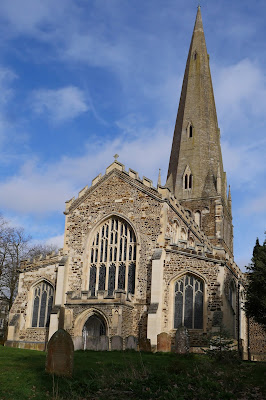The Town Council Offices
Fresh from an enjoyable exploration of Aylesbury, Merv and I decided to have a look at Leighton Linslade 15 minutes or so to the north.
Leighton Linslade used to be known as Leighton Buzzard, but the adjoining settlement of Linslade, separated only by the small river Ouzel, gradually coalesced with it and in 1965 the two settlements became a combined Urban District. Leighton Buzzard has always been an intriguing name and there are various theories about how it came about.
We started our walk at the Town Council offices which are in a large house of about 1850. We collected a copy of the Living History Trail, which we thought would offer a town walk. Sadly, it didn't do that (although the map of the main streets was handy) but the accounts of the doings of ordinary people were interesting.
From the Council Offices we headed down Leston Road to reach Lake street and the former Temperance Hall, now Lecton House.
From here we walked up Lake St to reach the Market Square with its 15th century Market Cross: "an uncommonly fine piece" according to Pevsner.
Nearby is the former Market Hall, which later became the Town Hall and in 1919 it was turned into the Fire Station. "Wholly undistinguished, wholly delightful" was Pevsner's assessment, with which I agree.
Opposite the Market Cross was the Swan Hotel with a delightful swan in the ballustrade.
Market Street gives way to the not-very-interesting High Street, but at the bottom the wide Church Square leads to the church of All Saints in the Perpendicular style of the 15th century.
Outside, I found this broken column to be an unusual and moving gravestone.
The church was severely damaged by fire in 1985, but has been restored exceptionally well. The nave and aisle roofs are in the East Anglian style with absolutely fabulous angels.
We have seen similar examples in Stamford and Norwich in recent years.
By chance we stumbled on the so-called Simon and Nellie story carved into a wall by the south west pier. They are the traditional inventors of the Simnel cake. Nellie is threatening Simon with a spoon.
As we headed back up the High Street we were struck by just how awful was this building on the corner of Church Square.
Returning to the Market Square we headed up North Street to see first the Wilkes Almshouses (established 1650, rebuilt 1857 and extended 1873.
And a little further on, in Church St, the Page Almshouses of 1903. "A sweet design" according to Pevsner. Certainly they are very picturesque.
We didn't get to see Linslade, thus missing a sight of the Grand Union Canal.
Conditions: grey, cool.
Distance: a couple of miles.
Rating: four stars. There was much more to it than I had expected.












No comments:
Post a Comment